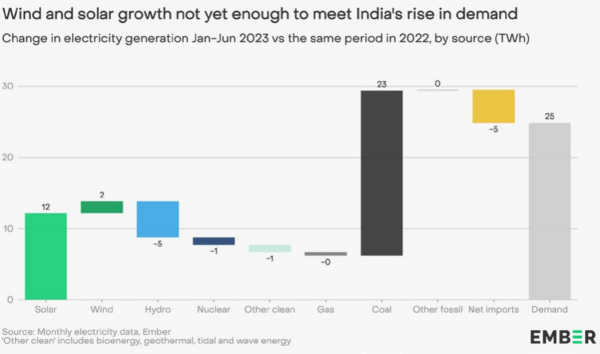India contributed 12% of global growth in solar generation in H1 2023
India’s growth in solar generation (+26%, +12 TWh) in the first half of 2023 was above the global average growth (+16%). In H1 2023, India contributed nearly as much new solar generation as the EU, with 12% of the global additions.
India contributed 12% of the global increase in solar generation in the first half of 2023, similar to the European Union, according to a report published by energy think tank Ember.
The Ember report analyses electricity data from January to June 2023, compared to the same period last year. It analyses data across 78 countries representing 92% of the global electricity demand.
At a global level, solar generated 5.5% of global electricity in the first half of 2023, an increase of 16% (+104 TWh) from the same period last year. India’s solar growth of 26% (+12 TWh) was above the global average, and powered half of the country’s demand increase in the same period, according to the report.
Fifty countries, including India in May, set new monthly records for solar generation in the first half of 2023. China continues to be the leader in solar generation, providing 43% of global growth in solar generation, while the EU, the US, and India accounted for about 12% each.

Across the first half of 2023, India generated 7.1% of its electricity from solar.
The report stated the increase in renewables in India, amid moderate demand growth, led to slow growth in coal generation. As a result, India’s power sector emissions grew by 3.7% (+19 million tonnes of CO2) in the first half of 2023, less than half of the growth seen in the first half of 2022 (+9.7%, +45 million tonnes of CO2). In India, the growth in wind and solar in the first half of 2023 prevented an increase of 11 million tonnes of emissions.
“India has the potential to be a major global player in solar power,” said Ember’s India analyst Neshwin Rodrigues. “Renewables are doing the job of slowing India’s emissions growth which is helping to get the world to a plateau in power sector emissions.”
That said, India’s growth in generation by solar in absolute terms was the same in the first half of 2022 and 2023 (+12 TWh). This means that solar’s relative growth is lower in the first half of this year (+26%) than in the same period last year (+35%). “India must push for larger solar power capacity additions in the next 4-5 years if it is to meet the targets set out in its new National Electricity Plan and retain its high growth rates”, adds Ember’s Asia Programme Lead, Aditya Lolla.

